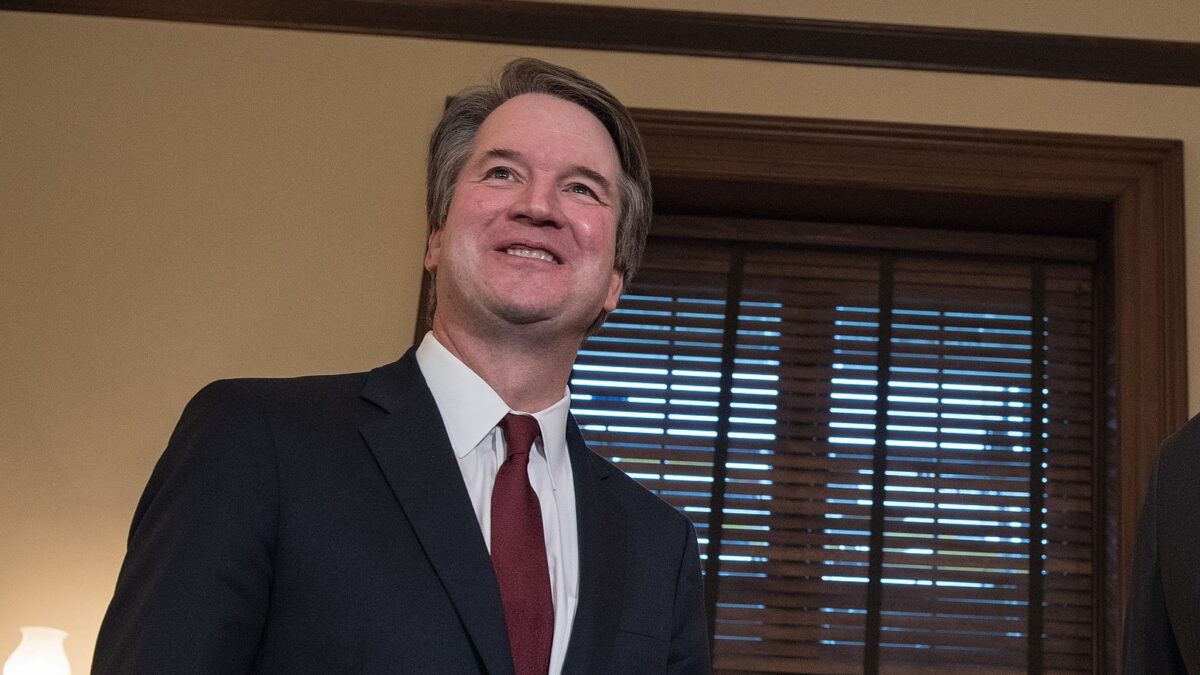The United States Supreme Court heard oral arguments in two companion cases, Relentless Inc. v. U.S. Dept. of Commerce and Loper Bright v. Raimondo on Wednesday. The bottom-line question before the court concerned whether Congress authorized the Department of Commerce to charge fishing businesses the cost of government-mandated observers on their rigs.
But answering that question requires the Supreme Court to first decide whether to overturn the landmark case of Chevron v. Natural Resources Defense Council, the namesake for the Chevron doctrine, which requires courts to defer to an agency’s interpretation of an ambiguous statute so long as the agency’s interpretation is “reasonable.” That’s what Wednesday’s arguments were all about — Chevron and whether the Supreme Court should do away with Chevron deference.
Here are your top takeaways from the hours-long arguments.
1. What Does Chevron Deference Mean?
A blackletter law definition of Chevron deference is easy to provide. As noted above, it is a legal principle that requires courts to defer to an agency’s reasonable interpretation of an ambiguous statute. But Wednesday’s hearing showed the contours of the doctrine are far from clear, with the justices jousting with the solicitor general, who represents the Department of Commerce, over the meaning of “ambiguous.”
A statute is “ambiguous,” Solicitor General Elizabeth Prelogar said, “when the court has exhausted the tools of interpretation and hasn’t found a single right answer.” But as Justice Gorsuch noted in response, just the prior year, a government attorney claimed he could not define “ambiguous.”
The meaning of “ambiguous” is key to the doctrine of Chevron deference, which requires two steps. At step one, a court is to “employ[] traditional tools of statutory construction” to determine “whether Congress has directly spoken to the precise question at issue.” According to Chevron, “[i]f the intent of Congress is clear, that is the end of the matter,” and the court must enforce the clear meaning.” But if “the statute is silent or ambiguous with respect to the specific issue,” then the court proceeds to step two, which requires the court to defer to an agency’s interpretation so long as it reflects a “permissible construction of the statute.”
So defining “ambiguous” matters, several of the justices stressed, pointing to the confusion of the lower courts on the question — something that would justify overturning Chevron.
2. Justice Kavanaugh Was a Star
Heading into Wednesday, court watchers knew three justices had already expressed disagreement with Chevron, including Justices Clarence Thomas, Neil Gorsuch, and Brett Kavanaugh. To date, Gorsuch has made some of the most resounding attacks on Chevron deference. And while Gorsuch landed some blows during oral argument, it was Kavanaugh who seemed to throw haymaker after haymaker.
Kavanaugh returned to ground zero — the Chevron decision — and pushed the solicitor general on what he saw as “an internal inconsistency in Chevron itself.”
“It related to footnote 9,” he explained. That footnote provides that “the judiciary is the final authority on issues of statutory construction and must reject administrative constructions which are contrary to clear congressional intent.” Accordingly, the Chevron court continued, “[i]f a court, employing traditional tools of statutory construction, ascertains that Congress had an intention on the precise question at issue, that intention is the law and must be given effect.”
Referencing that footnote, Kavanaugh continued, “if you use all the traditional tools of statutory interpretation, you’ll get an answer,” and therefore, there is no step two and no deference. And we know you get an answer, the Trump appointee stressed, “because, in cases where we don’t have an agency involved and we use those same traditional tools, we get an answer.”
Kavanaugh reiterated that point several times throughout the argument, namely that courts interpret statutes regularly, both ambiguous and unambiguous ones, implying that if judges did the tough work of statutory interpretation, there would be no step two deference required.
3. Stakes Are Enormous
Another notable theme from Wednesday was the effect of reversing Chevron.
Soon after arguments in Relentless began, Justice Elena Kagan monopolized the questioning by peppering the fishing company’s attorney with hypotheticals. What was most striking, though, were not the difficult scenarios posed, but her assertion that “the court is very rarely in the situation in which you’re talking where it thinks the law means X and instead it says Y,” because of deference under Chevron. “If it thinks it means X, under Chevron, as we’ve understood it and made clear and reigned it in a little bit over these last few years, it’s supposed to say X,” Kagan continued. Chevron really only applies, the Obama appointee suggested, when the “law runs out” and “there’s a genuine ambiguity.”
Kagan’s efforts to portray Chevron as a tie-breaker contrasted sharply with the sky-is-falling arguments the government presented. Overruling Chevron would “shock” “the legal system,” the solicitor general argued in her opening comments to the court. Yet later in her argument, she too seemingly acknowledged that many of the cases are resolved at the first step of Chevron, meaning deference is not even required. Under these circumstances, it is difficult to take seriously the worst-case-scenario prognoses presented by Chevron’s champions.
4. Congress Needs to Do Its Damn Job
Another common theme pushed, especially by Kagan, concerned the question of “who decides?” If there is an ambiguity, Kagan posed several times, do we want the agency or the courts to make the policy decision?
The correct answer, however, is neither: Congress should make policy decisions and draft statutes that provide clarity on the law. When Congress delegates authority to administrative agencies, such authority should similarly be clear.
Chevron deference has allowed Congress for far too long to avoid making tough calls, and while some of the justices seemed fine with that approach, it is inconsistent with our constitutional structure.
5. Stare Decisis
The prudential principle of stare decisis also featured heavily in oral arguments, with the government arguing it cuts against overturning the Chevron doctrine. Businesses need certainty, the solicitor general argued, and overturning Chevron would destroy the predictability of the law.
On the contrary, the fishing businesses’ attorneys stressed, what creates uncertainty is Chevron deference, which allows for each new administration to reverse prior regulations. Several justices seemed to share that viewpoint as well. Further, as several of the justices noted, the unworkability of a legal rule can justify its reversal, notwithstanding stare decisis — and several of the exchanges on Wednesday showed Chevron deference, in its current iteration, is unworkable.
6. Oh, the Humility!
Another key exchange originated when Kagan pushed Paul Clement, attorney for the fishermen in Loper Bright, on humility.
Chevron is a doctrine of humility, Kagan began, noting that in that doctrine the court “recognize[s] that there are some places where congressional direction has run out, and we think Congress would have wanted the agency to do something rather than the courts.”
“We accept that because that’s the best reading of Congress and also because we know in our heart of hearts that Congress — that agencies know things that courts do not,” she continued.
On top of that, Kagan noted that overturning Chevron conflicted with the principle of stare decisis — another doctrine of humility — which, as she put it, says “we don’t willy-nilly reverse things unless there’s a special justification.” Then came her talking point: “And you’re saying blow up one doctrine of humility, blow up another doctrine of humility, and then expect anybody to think that the courts are acting like courts.”
Kagan’s comments suggest she sought to sell Chevron to her fellow justices based on concerns over institutional integrity, while implying a vote to overturn that landmark case could only come from hubris.
Gorsuch, who filled the vacancy on the court left by Justice Antonin Scalia’s death and was having none of Kagan’s argument, called on his predecessor’s name in retort: “One lesson of humility is [to] admit when you’re wrong. Justice Scalia, who took Chevron, which nobody understood to include this two-step move as originally written, turned it into what we now know, and late in life, he came to regret that decision.”
7. Predictions
From oral argument, Gorsuch and Kavanaugh seem definite votes for reversing Chevron deference. Thomas, given his past writings, seems a likely vote for reversal. In one exchange, Justice Samuel Alito seemed to mirror much of Kavanaugh’s thinking, namely that the courts already interpret statutes in other areas, and can do so here too, without needing to defer to agencies.
Both Justices Roberts and Barrett were more coy in their questioning, creating uncertainty about their positions. Conversely Kagan, Sotomayor, and Jackson all favored the Chevron framework.
Bottom line: There is no sure-fire forecast of the outcome. But something Gorsuch said might provide the best insight into the likely result.
During one exchange, the solicitor general suggested that the court merely reiterate to the lower courts the importance of undertaking a robust step-one inquiry. Gorsuch pointedly protested that the court had already on multiple occasions reminded the lower courts of their responsibility under Chevron to conduct an extensive analysis of the statute to resolve the question prior to deferring to the agencies. What good is another reminder likely to do?
Right there could be the reason two undecided justices join to form a majority to overturn Chevron — it is just not workable because the lower courts won’t do the work required.
Disclosure: Margot Cleveland is Of Counsel with the New Civil Liberties Alliance, which represents Relentless and which filed an amicus curiae brief in Loper Bright. The views expressed here are her own.









